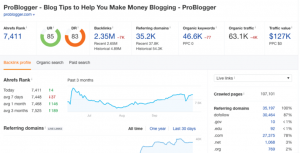 You’ve taken your startup off the ground and maybe even have a small team. Search engine optimization for your website wasn’t a priority till now. But you know very well that it’s what will help you bring traffic, turn visitors into leads, increase revenue, and build authority.
You’ve taken your startup off the ground and maybe even have a small team. Search engine optimization for your website wasn’t a priority till now. But you know very well that it’s what will help you bring traffic, turn visitors into leads, increase revenue, and build authority.
But how do you do SEO as a startup? If hiring an SEO specialist is out of the question, you have limited resources and need to get your first customers soon. You don’t consider yourself tech-savvy in this category, so what else can you do?
Don’t sweat it. Anyone can do SEO right — whether it’s a startup founder or a regular online business owner — as long as you’re using the right tools and are following the advice below.
Read More: How to Use Heat Maps Analytics to Enhance Your Onsite SEO
Startups need SEO in order to get access to your target market as soon as possible and make your brand visible. Some benefits include its cost-effectiveness and the fact that you won’t need to deal with ad campaigns, rely on the ever-changing landscape of social media or spend a ton of time growing an email list anymore. Here’s how to optimize your startup’s website:
1. Do Keyword Research
Keywords are the foundation of SEO. With good research and by following the best on-page SEO practices, you can improve the presence of all your web pages, appear on top of Google for competitive terms, and create every next piece of content with optimization in mind.
Keywords are the terms defining what your content is about. It’s best to optimize each blog post you publish or page you create for one main keyword while including secondary ones so it can rank for synonyms too.
It’s always smarter to go for long-tail keywords — those containing 3 or more words — which have less competition and for which you can rank faster. Google suggests you should write content for the reader. That means understanding user intent and publishing articles to answer the questions the searcher has. People are using more descriptive queries now and that’s why long-term keywords work so well.
Read More: 10 Highly Valuable Keywords to Include in Every MarTech Blog
Many popular marketers and bloggers have brought a massive amount of organic traffic to their sites solely due to targeting the right long-tail keywords. But how do you find them? Through keyword research. One of the most popular tools for that is Ahrefs.
In addition to helping you find topics in demand and profitable keywords, it also allows you to analyze your competitors and check backlinks, among other useful features.
Let’s see how to make the most of Ahrefs:
Once you’re in your Ahrefs dashboar d, click ‘Site Explorer’. There you can enter your domain or that of a close competitor and see other popular sites related to your niche and their backlinks. How is this helpful to you and your SEO strategy? Well, you can make a list of your biggest competitors, study their backlink profile, and find golden opportunities. After all, anyone who linked to them might be interested in you too if you have amazing services to offer or great pieces of content that provide value.
d, click ‘Site Explorer’. There you can enter your domain or that of a close competitor and see other popular sites related to your niche and their backlinks. How is this helpful to you and your SEO strategy? Well, you can make a list of your biggest competitors, study their backlink profile, and find golden opportunities. After all, anyone who linked to them might be interested in you too if you have amazing services to offer or great pieces of content that provide value.
To see how Ahrefs gives you that information, we’ll use the popular site in the blogging niche ProBlogger.com. This is the data you see once you enter the URL.

You can click ‘Competing domains’ in the sidebar on the left to see the competitors of the site you’re exploring.
Now that you have that list of competitors, you can export the data and keep it. You’d want to put each URL in Ahrefs again and see the keywords its ranking for.
It’s time to find keywords you can target and for which you can outrank the website already ranking for them. Make sure you only do that for domains with domain authority lower than yours so you can have a real chance of outperforming them. If you go after the other sites, your efforts will be wasted even if you create content better than theirs, simply because their backlink profile is so strong that Google favors them and shows them to visitors first.
Another great metric you can check using Ahrefs is the organic traffic each keyword brings on a monthly basis.
Here’s an example for lifehacker.com:

You wouldn’t want to go after a keyword that gets 200 or fewer hits per month as that’s not enough traffic to make a real difference for your business. So pick those that do bring a decent amount of traffic but don’t forget they should be connected to the topics you cover on your blog. One of the pillars of SEO is relevance, in addition to trust and authority.
2. Check the Top Ranking Pages for Your Chosen Keyword
The process we just described is called spying on your competitors and it’s what all SEO experts are doing. It’s natural and doesn’t involve stealing, but instead providing more value than the competitor and ranking a web page for a certain keyword higher than them because of that. By doing this, you can expect a significant boost in your traffic in as little as a few months.
Before you start creating content that will outrank your competitors, check the actual pages that appear on the top spots in Google.
That literally means typing the keyword in Google and visiting the sites showing up on the first page. You’d want to explore their writing style, see how long the content is, check their subheadings and find out how many times they used the exact keyword, look for visuals, etc.
Read More: Snapchat’s New Update Creates Huge Possibilities for Local SEO
The top 3 results are showing you what works best as that content obviously received backlinks, gets shared on social media and is optimized well. So you’d want to learn from them.
Here’s what you should keep in mind when writing articles for the keywords you chose:
- Make it longer than any of your competitors’;
- Pick a better title;
- Write in an easy to understand way;
- Keep it interesting;
- Make sure it’s informative by including practical tips and backing them up with stats;
- Cover more points than the top performing pages (never hurts to have a longer list of tips);
- Go the extra mile with visuals. Embed a video and a GIF, add an infographic and use high-quality images;
- Make the content on the page skimmable by using bullet points, breaking the text with many subheadings, and having shorter sentences and paragraphs instead of long ones.
When that’s done, publish your content and start doing outreach. Go back to Ahrefs and see all the websites who linked to the top performing page for that keyword. Head there, find the owner’s email and contact them to tell them you just created the best piece on the topic.
As new competitors will show up eventually, you can always go back to Ahrefs and see your ranking position. Updating your best articles that are optimized for keywords is a must. Add more content every few months if necessary, make changes as new trends in the market evolve, and format it better every next time. This encourages Google to crawl it again, see you’ve improved it, and keep you on the #1 spot.
3. Build Links to Your Content
Aside from that time-consuming SEO strategy, there are other ways to give a boost to pages that aren’t appearing in the SERPs just yet.
Let me start with the 2 methods that will require more effort but which can help you gain quality backlinks over time:
Read More: The New Content Workflow: Conductor Actions
The first one is guest posting, which can improve brand awareness, bring leads, and strengthen your backlink profile. It begins by choosing the right sites to guest post on, making your pitch, writing an incredible resource and optimizing it. Due to the site’s already established authority in the niche, your post has a real chance of ranking high in no time.
The second best method for link building is called Resource Page Link Building. Once you have great content on your site, reach out to other people with resource pages and suggest they include yours as you think it will be beneficial to their readers.
Some faster and cheaper ways to get links to your site include answering questions on Quora and including a link back to one of your articles, and commenting on blogs in your niche. Mario Peshev from DevriX is a great example of huge potential of Quora. He had been contributing answers to Quora for about an year, when one day he received a message by Addriene Gomer from the Quora staff, asking to republish one of his Quora answers on other platforms. In a few months, Mario’s answers got re-published on Forbes, Huffington Post, Slate, Apple News, Hacker Noon, Inc. and a few other sites.
Conclusion
Everything we mentioned so far might sound like a lot of work, but it’s all about creating a process and repeating it. Over time, you’ll do competitor analysis in minutes and will be able to pick the best keyword in a short amount of time, after which the content creation can begin.
The best part is that you’re guaranteeing that every piece of content you create and publish will get the attention it deserves. And organic traffic is the sweetest source of traffic as it brings you the right visitors, those ready to engage with your content and which can eventually become your customers.
Read More: Build, Borrow or Buy: Analytics Enablement for In-House Marketers
